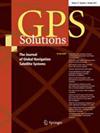Characterization of Galileo yaw attitude on tidal loading and range bias in SLR-based orbit validation
IF 3.9
1区 地球科学
Q1 REMOTE SENSING
引用次数: 0
Abstract
Abstract Satellite laser ranging (SLR) has been widely used for satellite orbit validation. SLR residual is defined as the difference between the satellite-station distance and the SLR ranging measurement. The SLR residual not only indicates the satellite orbit accuracy but also implies the force mis-modeling left from satellite orbit determination. We characterize satellite yaw attitude on the SLR residual of the Galileo orbit in terms of the tidal loading effect and the range bias estimated in the procedure of orbit validation. The attitude characterization is defined as the slope of the SLR residual as a function of the elongation angle, which is formed by the sun elevation with respect to the orbital plane and the difference in the argument of latitude of the satellite with respect to the sun. We find that the yaw attitude is insensitive to the surface deformation caused by the tidal loading due to the slight change in slope from − 0.0106 to − 0.0117 cm/°. However, this is not the case for the range bias estimated in the orbit validation procedure. The slope of the SLR residual is changed from − 0.0106 to − 0.0014 cm/° when the range bias is estimated. This indicates that the range bias is specific to the satellite yaw attitude, in particular for the beta angle less than 20°. In addition, the range bias has a relatively high dependency on the force mis-modeling, as compared to the tidal loading. This suggests that the yaw-related force mis-modeling shall be considered in the estimation of the range bias for the Galileo satellites. This work can serve as a reference for assessing the characterization of satellite yaw attitude on the tidal loading effect and the range bias estimated in the satellite orbit validation using SLR.基于slr的轨道验证中潮汐载荷和距离偏差的伽利略偏航姿态表征
摘要卫星激光测距技术在卫星轨道验证中得到了广泛的应用。单反残差定义为星站距离与单反测距值之间的差值。SLR残差不仅反映了卫星的轨道精度,还反映了卫星定轨后的力建模误差。根据潮汐载荷效应和轨道验证过程中估计的距离偏差,对伽利略轨道单反残差的卫星偏航姿态进行了表征。姿态特征定义为单反残差的斜率作为延伸角的函数,延伸角是由太阳相对于轨道平面的高度和卫星相对于太阳的纬度参数的差异形成的。我们发现偏航姿态对潮汐载荷引起的地表变形不敏感,因为坡度在- 0.0106到- 0.0117 cm/°之间有微小的变化。然而,对于轨道验证程序中估计的距离偏差,情况并非如此。当估计距离偏差时,SLR残差的斜率从- 0.0106变化到- 0.0014 cm/°。这表明距离偏差是特定于卫星偏航姿态的,特别是对于小于20°的β角。此外,与潮汐载荷相比,距离偏差对力错误建模的依赖性相对较高。这表明,在伽利略卫星的距离偏差估计中,应考虑偏航相关力的错误建模。该研究可为卫星偏航姿态对潮汐载荷效应的表征及单反卫星轨道验证中估计的距离偏差提供参考。
本文章由计算机程序翻译,如有差异,请以英文原文为准。
求助全文
约1分钟内获得全文
求助全文
来源期刊

GPS Solutions
工程技术-遥感
CiteScore
8.10
自引率
12.20%
发文量
138
审稿时长
3.1 months
期刊介绍:
GPS Solutions is a scientific journal. It is published quarterly and features system design issues and a full range of current and emerging applications of global navigation satellite systems (GNSS) such as GPS, GLONASS, Galileo, BeiDou, local systems, and augmentations. Novel, innovative, or highly demanding uses are of prime interest. Areas of application include: aviation, surveying and mapping, forestry and agriculture, maritime and waterway navigation, public transportation, time and frequency comparisons and dissemination, space and satellite operations, law enforcement and public safety, communications, meteorology and atmospheric science, geosciences, monitoring global change, technology and engineering, GIS, geodesy, and others.
GPS Solutions addresses the latest developments in GNSS infrastructure, mathematical modeling, algorithmic developments and data analysis, user hardware, and general issues that impact the user community. Contributions from the entire spectrum of GNSS professionals are represented, including university researchers, scientists from government laboratories, receiver industry and other commercial developers, public officials, and business leaders.
 求助内容:
求助内容: 应助结果提醒方式:
应助结果提醒方式:


